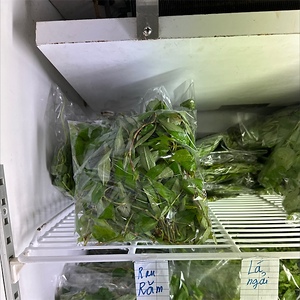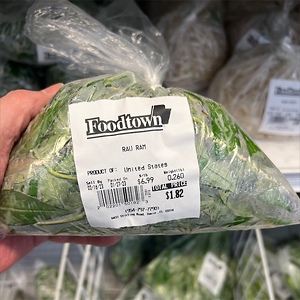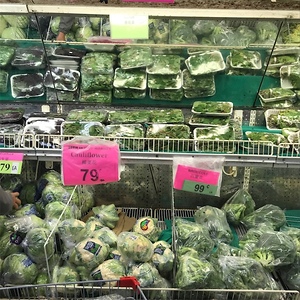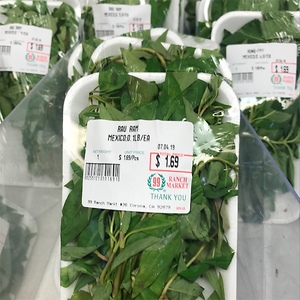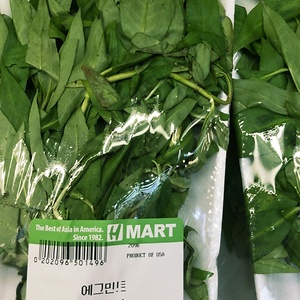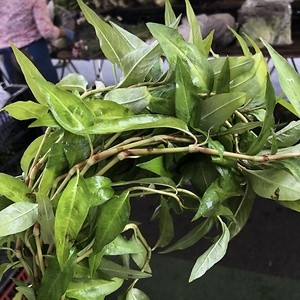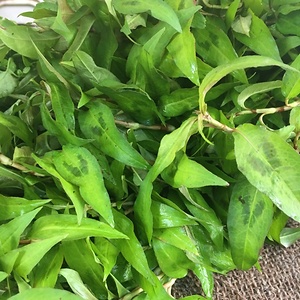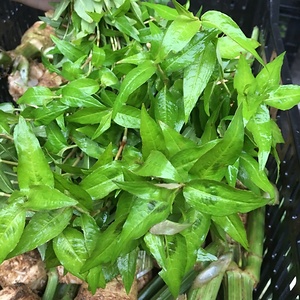

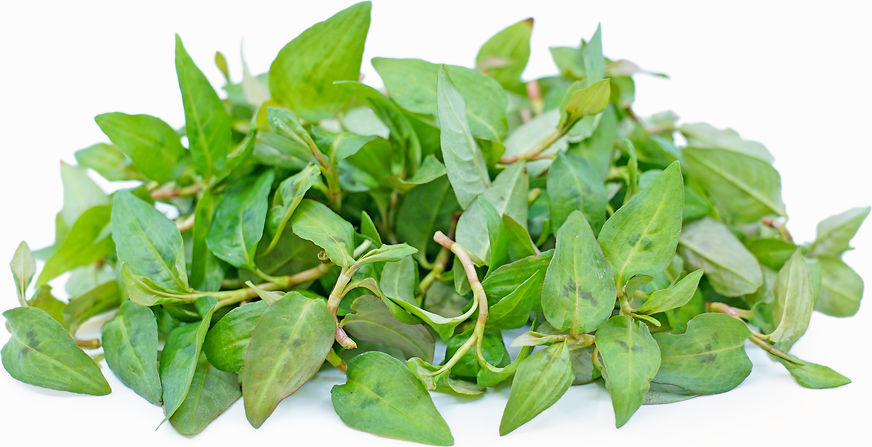
Rau Ram
Estimated Inventory, lb : 2.00
This item was last sold on : 05/02/25
Description/Taste
Rau Ram is an evergreen herb comprised of long, upright stems that sprout soft blade-like leaves, generally reaching 15 to 50 centimeters in height. The plant is secured by dense branching, red-brown roots embedded into the soil, allowing the stems and leaves to extend and trail away from the base. The stems are pale green, tinted red, and jointed at each stem and have a tubular, knobbed appearance with a woody consistency. The leaves have a lanceolate to oval, tapered look with smooth, flat edges that end in a distinct point on the non-stem end. Each leaf also ranges from 5 to 10 centimeters in length and is bright green, showcasing a small dark purple to maroon crescent marking at the base of the leaf with burgundy hues on the leaf’s underside. Rau Ram has a crisp, tender, and slightly chewy consistency with a faint aroma similar to the smell of coriander. The greens contain a peppery, spicy, vegetal, and herbal flavor, followed by citrus, musk, and spice notes.
Seasons/Availability
Rau Ram is available year-round in tropical to subtropical climates.
Current Facts
Rau Ram, botanically classified as Persicaria odorata, is an herbaceous perennial belonging to the Polygonaceae family. The leafy herb is a fast-growing, trailing plant native to Southeast Asia is often found as ground cover around trees and water-filled areas. Rau Ram has been utilized in medicinal and culinary preparations for thousands of years and is also known as Vietnamese Cilantro, Vietnamese Coriander, Hot Mint, Laksa Plant, Cambodian Mint, Daun Kesum, Praew Leaf, and Phak Phai. The herb was traditionally foraged from wild plants, but over time, the plant has been incorporated into home gardens, used as a fresh flavoring for stir-fries, soups, salads, and noodle-based dishes. Rau Ram matures in approximately 30 to 45 days and is favored for its robust, complex flavoring reminiscent of cilantro.
Nutritional Value
Rau Ram has not been studied for its nutritional content. In natural medicines of Southeast Asia, the herb has been consumed for its anti-inflammatory and digestive properties. Rau Ram is believed to warm the digestive tract and contain some fiber, cleansing the body regularly. The leaves are also taken to strengthen the immune system against colds and flu. In Vietnam, Buddhist monks cultivate and consume Rau Ram, which is believed to help lower libido and maintain celibacy.
Applications
Rau Ram has a peppery, herbal, and warm flavoring well suited as a fresh component to raw and cooked preparations. It is recommended to use Rau Ram in dishes with other strongly flavored foods to help balance the taste, and the herb is almost always used fresh. Drying Rau Ram or cooking it for extended periods will cause it to lose its flavor. Rau Ram can be used in the same manner as cilantro and has a similar texture, aroma, and taste. The leaves can be wrapped into spring rolls, layered into sandwiches, tossed into salads, especially larb, or mixed into stir-fries. Rau Ram can also be sprinkled over curries, fish stews, and soups such as pho, or it can be topped over omelets, mixed into chicken and rice dishes, or stirred into marinated cucumber salads. Beyond traditional Southeast Asian dishes incorporating Rau Ram, the herb can be chopped into pico de gallo as an unusual twist or blended into sauces such as pesto. Rau Ram pairs well with meats such as duck, poultry, pork, and lamb, seafood including white fish, crab, and shrimp, aromatics such as ginger, mint, lemongrass, green onions, and chile peppers, coconut milk, cabbage, carrots, and citrus. Whole, unwashed Rau Ram will keep for several days when stored in between damp paper towels in an open plastic bag in the refrigerator. The leaves should be immediately consumed for the best quality and flavor. The leaves can also be soaked in ice water to reinvigorate wilted leaves.
Ethnic/Cultural Info
In Southeast Asia, incubated duck eggs served with Rau Ram are a typical street food consumed as a nutritious snack. The dish is known as balut in the Philippines, phog tea khon in Cambodia, maodan in China, and hot vit lon in Vietnam, and the eggs are served when they are approximately 14 to 21 days old depending on consumer preference. The eggs are boiled for 45 minutes to 1 hour and served whole with herbs, salt, lime juice, or vinegar. In Vietnam, hot vit lon is believed to bring vital nutrients to the body. It is customary for women to consume the eggs after giving birth to help the body heal and repair. While the snack seems somewhat unusual to the Western world, as all parts of the partially developed duck fetus are consumed, hot vit lon is a cultural staple embedded into the history and lifeblood of Southeast Asian cuisine. Consuming the entire fetus is a sign of respect for the animal and limiting food waste. The eggs are also often eaten with fresh herbs to create balanced, yin and yang flavor components. Rau Ram is said to have warming properties and is consumed with every bite as a contrast to the cool nature of the egg. In the Philippines, balut has been unofficially labeled as the country’s national street food, and the eggs are sold at all hours during the day. At nighttime, it is common to drink a beer with the egg to wash down flavors.
Geography/History
Rau Ram is native to tropical and subtropical regions across Southeast Asia and has been growing wild since ancient times. The herb favors moist and damp climates, especially near ponds, streams, and lakes, and is found growing wild and cultivated in home gardens. In the mid 20th century, Rau Ram was introduced to Western Europe and North America through migrating Vietnamese populations due to Southeast Asia's political, religious, and socioeconomic struggles. The herb was not widely naturalized in these regions, but many Vietnamese communities began planting and cultivating Rau Ram in their gardens. Today Rau Ram is found in Southeast Asia, Europe, and North America. The herb is most commonly sold through specialty grocers, distributors, or local Asian markets.
Recipe Ideas
Recipes that include Rau Ram. One



